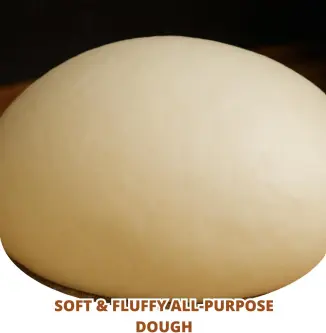Description: This versatile dough recipe is your go-to for creating a wide array of delectable baked goods, from sweet rolls and pizzas to savory breadsticks and fluffy buns. It’s incredibly easy to make, yielding a consistently soft, light, and airy texture that will elevate all your baking endeavors. The addition of vinegar is a secret weapon, enhancing the dough’s tenderness and elasticity.
Ingredients:
- 1 cup warm milk (about 105-115°F) – Whole milk is recommended for richer flavor, but 2% or even non-dairy alternatives like almond or soy milk can be used. Just ensure the liquid is warm to activate the yeast effectively. The warmth helps the yeast thrive and create the gases necessary for a good rise. Using milk adds to the richness of the dough compared to only using water.
- 1 cup warm water (about 105-115°F) – The water should also be warm, not hot, to avoid killing the yeast. A kitchen thermometer is your best friend for ensuring the correct temperature. Using a combination of milk and water creates the perfect texture and balances flavor.
- 1/2 cup vegetable oil – Vegetable oil provides moisture and richness to the dough, ensuring a soft and tender crumb. You can substitute with canola oil, melted coconut oil (cooled slightly), or even olive oil for a slightly different flavor profile. Olive oil imparts a more distinct flavor, which can be desirable for savory applications.
- 1 tablespoon granulated sugar – Sugar feeds the yeast, promoting its growth and activity. It also adds a subtle sweetness to the dough, enhancing the overall flavor. Brown sugar can be used for a slightly richer, molasses-like flavor.
- 2 tablespoons active dry yeast – This is the key ingredient that makes the dough rise. Ensure your yeast is fresh for optimal results. If unsure, you can proof the yeast by mixing it with the warm milk, water, and sugar; if it foams within 5-10 minutes, it’s good to use. Instant yeast can also be used, but it can be added directly with the flour.
- 1 teaspoon baking powder – Baking powder provides an extra boost of lift, contributing to the dough’s overall lightness and fluffiness. It works in tandem with the yeast to create a superior texture.
- 1 teaspoon salt – Salt controls the yeast activity and enhances the flavor of the dough. Don’t skip it! It’s crucial for balancing the sweetness and adding depth of flavor.
- 1 tablespoon white vinegar – This is a secret ingredient! Vinegar tenderizes the gluten strands, resulting in a softer, more pliable dough. You won’t taste it in the final product. Apple cider vinegar can also be used.
- 5 cups all-purpose flour – All-purpose flour provides the structure for the dough. Measure it accurately using the spoon and level method (spoon flour into the measuring cup and level off with a knife) to avoid adding too much, which can result in a dense dough. Bread flour can be used for a chewier texture, but all-purpose flour is ideal for the soft and fluffy result we’re aiming for.
Preparation:
Step 1: In a large mixing bowl, combine the warm milk, warm water, sugar, and active dry yeast. Stir gently with a whisk or spoon to dissolve the sugar and yeast. Allow the mixture to sit undisturbed for about 10 minutes. This step, known as proofing, ensures that the yeast is active and viable. After 10 minutes, the mixture should be foamy or bubbly on top, indicating that the yeast is working. If it doesn’t foam, the yeast may be old or the liquid may have been too hot, killing the yeast. In that case, you’ll need to start with fresh yeast and make sure your liquids are within the recommended temperature range.
Step 2: Add the vegetable oil, white vinegar, salt, and baking powder to the yeast mixture. Stir well to combine all the wet ingredients. The vinegar may cause a slight fizzing reaction with the baking powder, which is perfectly normal and helps to activate it. Make sure the salt is fully dissolved, as undissolved salt can inhibit yeast activity.
Step 3: Gradually add the all-purpose flour, one cup at a time, to the wet ingredients. After each addition, mix well using a wooden spoon or a stand mixer fitted with a dough hook. As the dough begins to come together, it will start to pull away from the sides of the bowl.
Step 4: Once the dough becomes too thick to stir with a spoon, turn it out onto a lightly floured surface. Knead the dough for about 8-10 minutes. If using a stand mixer, knead with the dough hook on medium speed for the same amount of time. As you knead, the dough will become smoother, more elastic, and less sticky. If the dough is too sticky, add a tablespoon of flour at a time until it reaches the desired consistency. Avoid adding too much flour, as this can make the dough dry and dense. The dough should be soft and slightly tacky but not stick to your hands.
Step 5: Lightly grease a large bowl with vegetable oil or cooking spray. Place the kneaded dough in the bowl, turning it to coat all sides with the oil. This prevents the dough from drying out during rising. Cover the bowl tightly with a clean kitchen towel or plastic wrap. Place the bowl in a warm, draft-free place to rise for about an hour, or until the dough has doubled in size. The rising time may vary depending on the temperature of your environment. A warm oven (turned off) or a sunny windowsill can be ideal spots for rising.
Why You Will Love This Recipe:
This all-purpose dough recipe is a baking game-changer. Its versatility allows you to create countless delicious treats with minimal effort. The texture is consistently soft, fluffy, and light, making it perfect for everything from sweet pastries to savory breads. The addition of vinegar is a brilliant touch, enhancing the dough’s tenderness and elasticity without affecting the flavor. The recipe is also very forgiving and easy to adapt to different flavor profiles and dietary needs. Whether you are a novice baker or an experienced pro, this dough will become a staple in your kitchen. Plus, the satisfaction of making your own dough from scratch is unmatched!
COOKING Rating:
Easy
Serving Suggestions:
- Sweet Rolls: Divide the dough into small pieces, roll them out, spread with your favorite filling (cinnamon, brown sugar, butter), roll them up, and bake until golden brown.
- Pizza Crust: Roll out the dough to your desired thickness, top with your favorite sauce, cheese, and toppings, and bake until the crust is golden and the cheese is melted and bubbly.
- Breadsticks: Roll out the dough, cut into strips, brush with melted butter, sprinkle with garlic powder or sesame seeds, and bake until golden brown and crispy.
- Dinner Rolls: Shape the dough into small balls, place them in a baking pan, and bake until golden brown. Serve warm with butter.
- Calzones or Strombolis: Roll out the dough, fill with cheese, meats, and vegetables, fold over, seal the edges, and bake until golden brown.
Tips:
- Ensure your yeast is fresh and active for optimal rising.
- Use warm (not hot) liquids to activate the yeast without killing it.
- Measure the flour accurately to avoid a dense dough.
- Knead the dough thoroughly to develop the gluten and create a soft, elastic texture.
- Allow the dough to rise in a warm, draft-free place for best results.
- Don’t overbake! Keep a close eye on your baked goods to prevent them from drying out.
- For a richer flavor, substitute half of the milk with heavy cream.
- Experiment with different flours, such as whole wheat or spelt, for a healthier twist.
Prep Time:
20 minutes
Cook Time:
Variable, depending on the recipe you are making with the dough.
Total Time:
1 hour 20 minutes (including rising time)
Nutritional Information:
(Approximate per serving, varies greatly depending on the final product and serving size)
- Calories: 200-250
- Protein: 5-7 grams
- Sodium: 150-200mg
Conclusion
This Soft & Fluffy All-Purpose Dough recipe is an essential tool for any baker. Its simple ingredients and straightforward instructions make it accessible to beginners, while its versatility ensures that even seasoned bakers will find it indispensable. From sweet treats to savory delights, this dough provides the perfect foundation for countless culinary creations. So, roll up your sleeves, gather your ingredients, and get ready to enjoy the delightful aroma of freshly baked goodness!
Questions and Answers:
Q1: Can I use instant yeast instead of active dry yeast?
A: Yes, you can! If using instant yeast, you can skip the proofing step and add it directly to the flour along with the other dry ingredients. The process will still be the same, but using instant yeast reduces the waiting time. Be sure to use the same amount (2 tablespoons).
Q2: What if my dough doesn’t double in size after an hour?
A: Several factors can affect the rising time of your dough. The most common culprit is the temperature. If your kitchen is cold, the yeast will take longer to activate and rise. Try placing the dough in a warmer spot, such as a warm oven (turned off) or near a sunny window. Also, ensure your yeast is fresh; old yeast may not rise properly. If it still doesn’t rise after another 30-60 minutes, it might be best to start with fresh yeast. Sometimes dough may need 2 hours to proof properly.
Q3: Can I freeze this dough for later use?
A: Absolutely! This dough freezes beautifully. After the first rise, punch down the dough and shape it into the form you desire. Wrap the dough tightly in plastic wrap and then place it in a freezer bag. It can be stored in the freezer for up to 2-3 months. When ready to use, thaw the dough in the refrigerator overnight, and then let it rise again in a warm place until doubled in size before baking.
Q4: Can I use a stand mixer to make this dough?
A: Yes, a stand mixer makes the process even easier! Attach the dough hook to your stand mixer and follow the instructions as written. Knead the dough on medium speed for about 8-10 minutes, or until it’s smooth and elastic. Keep an eye on the dough’s consistency, adding a bit more flour if needed.
Q5: What can I do if my dough is too sticky?
A: A sticky dough is a common problem, but it’s easily fixed. Add a tablespoon of flour at a time while kneading, until the dough becomes smooth and slightly tacky but no longer sticks to your hands or the work surface. Be careful not to add too much flour, as this can result in a dry and dense dough. Also, avoid the temptation to add flour at the initial liquid-mixing stage. It’s often better to let the kneading process fully develop the gluten before determining if additional flour is needed.




